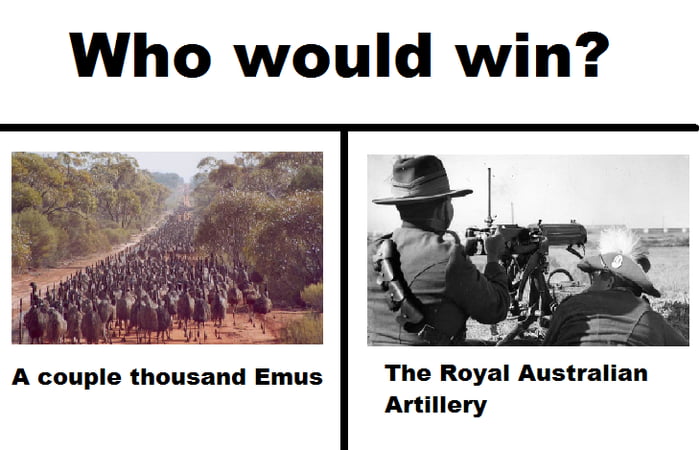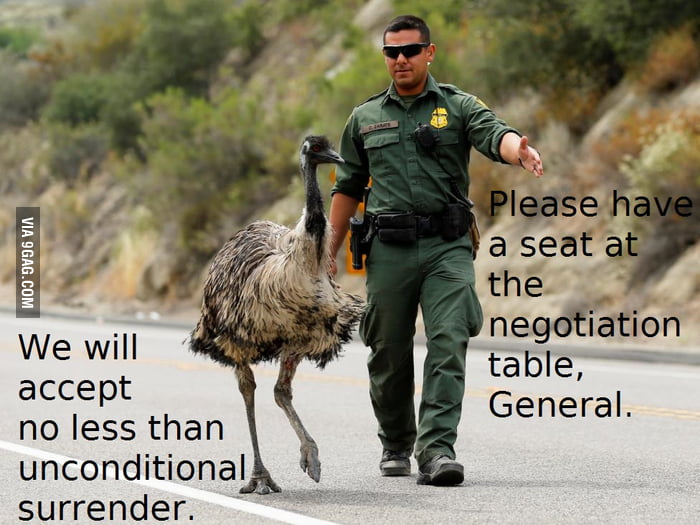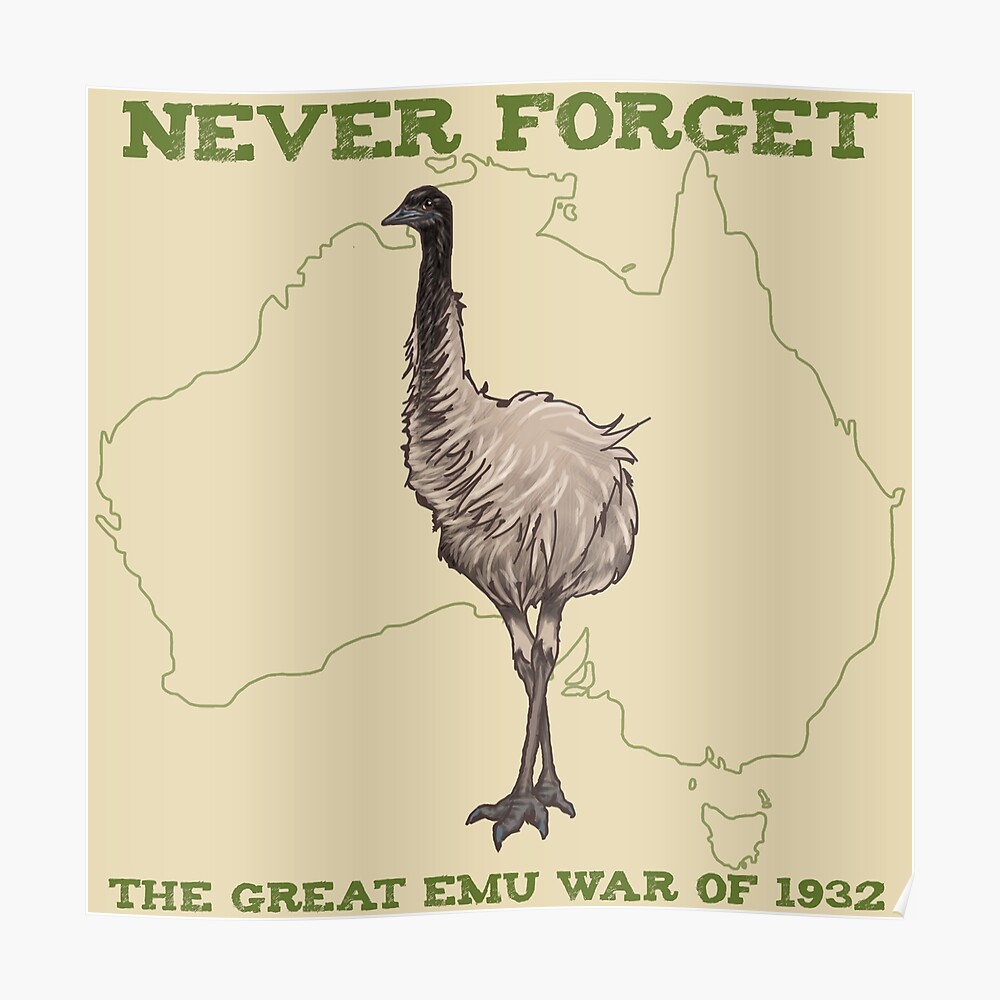The Emu War is one of Australia's most curious and bizarre historical events. It took place in late 1932, when a large number of emus, flightless birds native to Australia, caused significant damage to crops in Western Australia.
In response, the Australian government sent a small military force, led by Major G.P.W. Meredith of the Royal Australian Artillery, armed with two Lewis guns and 10,000 rounds of ammunition, to the region in November 1932. The plan was to cull the emus and reduce their numbers to protect the crops.
Curious? I am not surprised. Hell, if if the Australian Army couldn't despatch a few pesky birds then something was very wrong indeed. So let me enlighten you and tell you all about the time that the Australian Army went to war against its coat of arms.... and lost.
Australia does not have an official national bird, but unofficially, it is widely accepted to be the emu. This impressive bird is pictured on the national coat of arms alongside another of Australia's most peculiar animals, the red kangaroo.

The Emu War of 1932 was a peculiar event in Australian history that took place in the Western Australian region of Campion during the Great Depression. The "war" wasn't a conventional conflict between nations but rather a unique and comical struggle between Australian farmers, the Australian Army and a large population of emus.
During this time, many World War I veterans were given land to farm as part of a government programme to help them reintegrate into civilian life. However, the area faced economic challenges, including the Great Depression, and the farmers were struggling to make a living. Some 20,000 emus migrating inland during their breeding season decided that they wouldn't mind having a go at a bit of farming as well and they packed up shop and headed off to greener pastures. The birds had been protected as a native species until 1922, but now that they were classified as “vermin,” so all bets were off.

The emus, driven by the need for food and water, began to wreak havoc on the farmers' crops. They would feed on and destroy the wheat fields, which were vital for the livelihood of the settlers. The farmers, desperate to protect their crops, requested assistance from the Australian government.

In response, the government sent soldiers armed with two Lewis machine guns and 10,000 rounds of ammunition to assist the farmers in dealing with the emu infestation. The "war" began in November 1932 when the soldiers arrived and attempted to use the machine guns to shoot the emus.

However, the "war" did not go as planned:
-
First Encounter (November 2, 1932): The soldiers encountered about 50 emus. They fired at the birds, but due to the emus' speed and agility, only a few were killed, and the rest scattered.
-
Second Attempt (November 4, 1932): Another attempt was made, this time on a larger group of about 1,000 emus. Unfortunately, the gun jammed after killing just a few birds, and again, the majority of the emus escaped.
-
Ongoing Struggles: Over the next several days, the military attempted to outsmart the emus, but the birds proved to be surprisingly resilient. They moved in smaller, more dispersed groups, making it difficult to target them effectively. Even when the soldiers managed to kill some birds, the number was negligible compared to the vast emu population.

Despite their best efforts, the soldiers had limited success. After a few weeks of futile attempts, the government decided to withdraw the military assistance in December 1932. By that time, it was estimated that only a small fraction of the emus had been culled, and the emus continued to cause problems for the farmers. Major Meredith reportedly remarked on the emus' incredible endurance and cleverness, noting that they could face machine guns with little fear.
The Emu War was summarised by Australian ornithologist D.L. Serventy: “The machine-gunners’ dreams of point blank fire into serried masses of Emus were soon dissipated. The Emu command had evidently ordered guerrilla tactics, and its unwieldy army soon split up into innumerable small units that made use of the military equipment uneconomic. A crestfallen field force therefore withdrew from the combat area after about a month.”

The Emu War is now remembered as a humourous and somewhat embarrassing episode in Australian history. It highlighted the resilience and agility of the emus and the challenges faced by both the farmers and the soldiers involved. While the "war" ultimately ended without a clear victory, it surely serves as reminder that an indigenous Aussie has a distinct advantage when on home territory.
By 1934 the government had begun to supply farmers with ammunition and had created bounties for emu hunting. Roughly 57,000 bounties for dead emus were claimed in six months. The only permanent defense against emus proved to be the expansion of fencing over long distances. However, this was controversial, and authorities were accused of endangering the survival of the emu as a species by preventing them from completing their migrations. Australian wild emus became formally protected by the Environment Protection and Biodiversity Conservation Act in 1999.
So why is this event from so many decades ago worth retelling?
Well, as my brother is often known to say, " there's a lesson to be learned here. "
1. Fences and walls work to keep pests out.
2. Wars are won and lost depending on the cunning of the opposing side.
3. Never under estimate a bloke from the Australian bush.
I wonder how the Australian Army would fare today?

Footnote for those who would like to know more about Old Man Emu. They can stand up to 6 feet (1.8 metres) tall, with males and females generally similar in size. They weigh between 40 to 132 pounds (18 to 60 kilograms).
Like ostriches, emus are flightless due to their small wings relative to their large body size. However, they are excellent runners, capable of sprinting at speeds of up to 30 miles per hour (50 kilometres per hour).
Emus are omnivores, feeding on a variety of plants, seeds, fruits, insects, and small animals. Emus are generally solitary birds but can be found in pairs or small groups. During certain times of the year, particularly when food is abundant, they may form larger flocks.
The breeding season for emus usually occurs between May and August. After mating, the female lays between 5 and 15 large, dark green eggs in a ground nest. Interestingly, it is the male emu who incubates the eggs and takes care of the young. The male incubates the eggs for about eight weeks, during which he does not eat or drink and loses a significant amount of body weight.
Once the chicks hatch, they stay with their father for up to six months. Emus are an important cultural symbol in Australia. They appear on the Australian coat of arms, alongside the kangaroo, symbolising progress (as both animals are unable to move backward easily).




















































